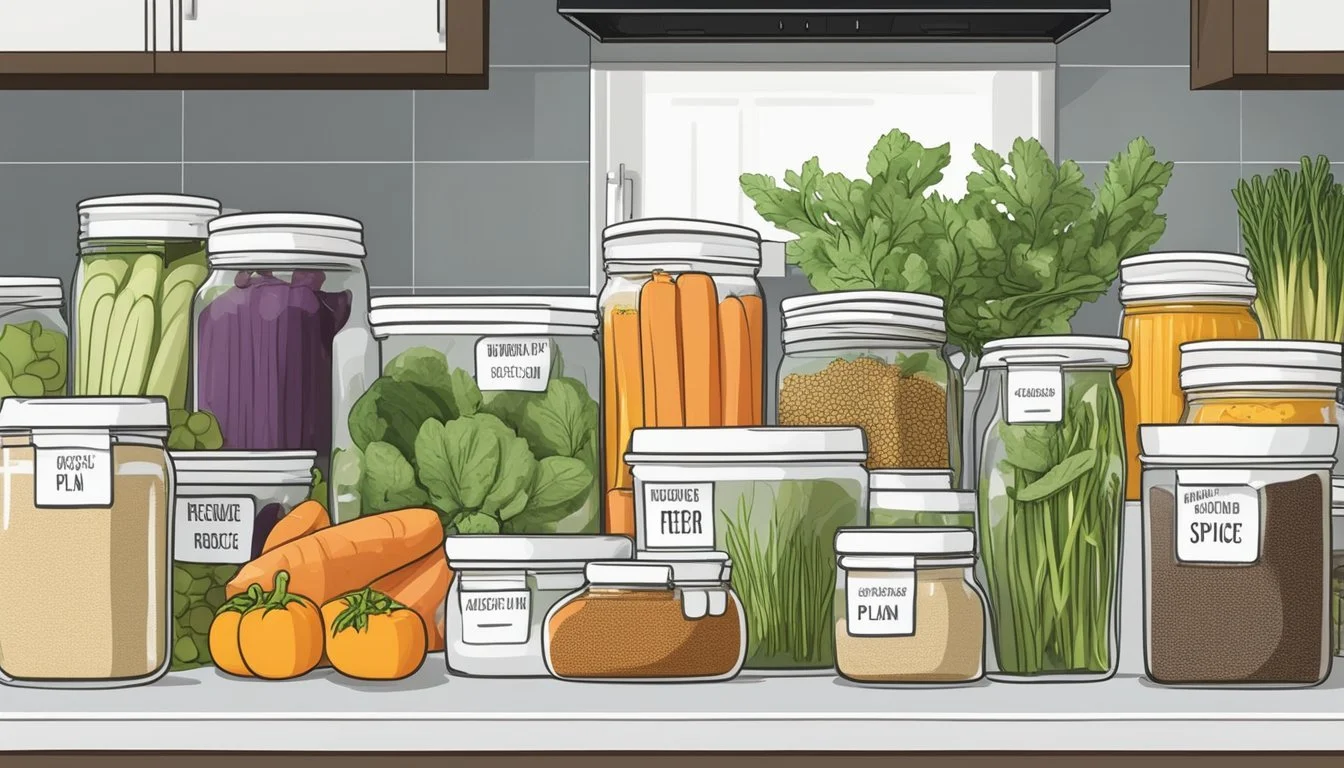The Ultimate Guide to Organizing Your Kitchen for an Autoimmune Protocol Diet
Streamlined Strategies for Health-Focused Cooking
The Autoimmune Protocol (AIP) diet is an elimination and reintroduction protocol designed for those with autoimmune diseases, aiming to alleviate symptoms and identify food sensitivities. To successfully adhere to this diet, organizing the kitchen is a pivotal step that can streamline the process and ensure compliance. A well-organized kitchen minimizes cross-contamination with non-compliant foods and simplifies meal preparation, making it easier to maintain this healing dietary approach.
When organizing a kitchen for the AIP diet, it's important to prioritize accessibility to AIP-compliant foods. This means strategically placing nutrient-dense, whole foods like vegetables, fruits, quality meats, and permissible fats within easy reach. It's equally essential to understand which items to eliminate, such as grains, legumes, dairy, refined sugars, processed foods, and specific additives known to cause inflammation or gut irritation. Establishing designated zones in the kitchen for different food categories can prevent confusion and help sustain focus on suitable options.
Accomplishing a clear distinction between AIP-friendly items and others is crucial in kitchen organization. Transparent labeling and the utilization of separate storage containers can help avoid accidental ingestion of restricted foods. This level of organization supports individuals in managing their autoimmune conditions by providing a structured environment that is conducive to the strict dietary guidelines of the AIP diet.
Understanding Autoimmune Protocol Diet
The Autoimmune Protocol Diet (AIP) is tailored for individuals managing autoimmune diseases, which are conditions where the immune system mistakenly attacks the body's own tissues. The AIP diet is structured to reduce inflammation and help in healing the gut, as a significant amount of the immune system is housed in the gastrointestinal tract.
This diet goes beyond the typical Paleo framework by imposing stricter guidelines, aimed at reducing potential food triggers that can worsen symptoms of autoimmune conditions. The two-phase approach begins with an elimination phase, where foods that are likely to cause inflammation, such as grains, legumes, nuts, seeds, nightshade vegetables, and dairy, are completely removed from the diet.
During the elimination phase, individuals may also avoid:
Products containing gluten
Eggs
Seed-derived spices
Once a noticeable improvement in symptoms is observed, the reintroduction phase commences. This involves cautiously readding foods one at a time and monitoring reactions closely, which allows for the identification of specific dietary triggers.
In addition to dietary adjustments, AIP emphasizes whole, nutrient-dense foods and encourages practices that support overall well-being, including stress management and adequate sleep. It is grounded in the understanding that a holistic approach is imperative for people with autoimmune conditions to manage their health effectively.
Fundamentals of the AIP Diet
The Autoimmune Protocol (AIP) Diet stems from a strategy to reduce inflammation and relieve symptoms associated with autoimmune diseases such as rheumatoid arthritis, inflammatory bowel disease, and celiac disease. This diet involves strict elimination of certain food groups believed to be potential triggers for autoimmune reactions.
Core Components of the AIP Diet:
Elimination Phase: The initial step requires the exclusion of:
Grains (e.g., wheat, rice)
Legumes (e.g., beans, lentils)
Nuts and Seeds
Dairy products
Alcohol
Food Additives
Eggs
Coffee and certain Teas
The rationale behind this phase is to remove any foods that may cause gut inflammation or have been commonly linked to immune responses.
Reactivity and Reintroduction:
After the elimination phase, the diet shifts into careful reintroduction of foods, observing the body's reactions. Foods are reintroduced one at a time, starting with those considered least likely to trigger symptoms. It is crucial that individuals monitor their symptoms closely and gauge reactivity to specific foods.
AIP's Aim:
The ultimate goal of the AIP diet is not lifelong restriction but to identify personal triggers and create a customized diet that manages an individual's autoimmune condition effectively. By doing so, it can potentially improve the quality of life for those managing chronic autoimmune diseases.
Essential Foods for AIP
In constructing a kitchen environment supportive of the Autoimmune Protocol Diet, it is crucial to stock foods that align with AIP principles—focusing on gut health and reducing potential dietary triggers for autoimmune responses.
Quality Proteins
The AIP emphasizes the consumption of high-quality proteins, as they are foundational for healing and maintaining muscle health. Preferred options include grass-fed beef, pasture-raised poultry, wild-caught fish, and organ meats such as liver.
Organic Vegetables
Organic vegetables form the backbone of the AIP diet, providing essential nutrients and fiber. Focus on a variety of vegetables, especially dark leafy greens and deeply-colored veggies, while avoiding nightshades which are restricted on the AIP.
Healthy Fats
Fats are vital for absorption of fat-soluble vitamins and overall health. The AIP recommends fats like olive oil and avocado oil for their anti-inflammatory properties. Use these oils for salad dressings and low-heat cooking.
Selected Fruits
While moderation is key, fruits can be included—particularly those lower in sugar. Berries and melons are favorable choices due to their nutrient density and lower impact on blood sugar levels.
Beneficial Fermented Foods
Fermented foods (What wine goes well with fermented foods?) such as sauerkraut, kombucha, and kimchi are included in AIP for their beneficial probiotic content which can aid in gut health. Always choose options without added sugars or non-AIP ingredients.
Natural Sweeteners and Spices
Use honey, maple syrup, and stevia sparingly as natural sweeteners. Flavor your dishes with AIP-compliant herbs and spices like cinnamon and turmeric, which can offer anti-inflammatory benefits.
Bone Broth and Gut Health
Bone broth is rich in nutrients that support gut health and is a cornerstone of the AIP diet. Regular consumption helps to nourish and repair the gut lining, potentially easing autoimmune symptoms.
AIP-Friendly Oils and Fats
For cooking and baking, AIP-friendly oils and fats such as coconut oil and coconut milk are excellent choices due to their stable saturated fat content. These can also provide a good energy source for those on the AIP diet.
Foods to Avoid on AIP
When embarking on the Autoimmune Protocol (AIP) diet, one needs to eliminate certain foods that may trigger an immune response or harm gut health. Here's a comprehensive list of what to steer clear of:
Grains
All grains are to be avoided due to their potential to irritate the gut lining and contribute to inflammation.
Legumes
This category includes beans, lentils, peanuts, and soybeans, which may contain lectins and phytates that can contribute to leaky gut.
Nuts and Seeds
Though often considered healthy, in the AIP diet, nuts and seeds can exacerbate inflammation in those with autoimmune conditions.
Dairy Products
Dairy is omitted because of its high allergenic potential and association with gut inflammation.
Alcohol
All forms of alcohol are excluded as they can impair the gut barrier and lead to increased inflammation.
Eggs
Both the whites and yolks of eggs are eliminated due to their capacity to trigger immune responses in some individuals.
Coffee and Tea
With coffee being a seed and tea potentially cross-reactive, they're excluded to prioritize gut healing.
Food Additives
Artificial ingredients and preservatives can adversely affect gut integrity, hence they are to be avoided.
Nightshade Vegetables
This group includes tomatoes, eggplants, peppers, and potatoes, which contain solanine that can trigger immune reactions in some individuals.
Processed Vegetable Oils
Oils like canola, sunflower, and corn oil are high in omega-6 fatty acids and can contribute to inflammation.
Tobacco
Tobacco is not allowed due to its wide range of health risks and inflammatory properties.
NSAIDs
Non-steroidal anti-inflammatory drugs (NSAIDs) are avoided because they can damage the gut lining.
The intention of avoiding these foods is to help heal the gut and lower inflammation in the body. It's imperative for those with autoimmune conditions to follow these elimination guidelines strictly to potentially see improvements in their health.
Addressing Common Symptoms
When individuals embark on an Autoimmune Protocol (AIP) Diet, they aim to mitigate symptoms commonly associated with autoimmune conditions, such as inflammation, pain, and fatigue. To effectively use the AIP Diet for symptom relief, here are strategies that involve organizing the kitchen:
Inflammation Reduction: A well-organized kitchen should prioritize anti-inflammatory foods front and center. Incorporate vegetables and fruits known for their anti-inflammatory properties.
Pain Management: Consider storing spices such as ginger and turmeric within easy reach, as these can contribute to natural pain relief.
Combat Fatigue: Position energy-boosting snacks like coconut flakes or AIP-compliant smoothie ingredients at eye-level in the pantry or refrigerator.
Stress Reduction: Clutter-free countertops and well-labeled storage can create a calming environment, reducing stress which can exacerbate symptoms.
For those experiencing leaky gut, an organized kitchen can simplify the preparation of gut-healing bone broths and fermented foods. Users should group ingredients together for quick access to streamline the cooking process.
Below is a suggested pantry setup:
Shelf Contents Top Shelf Anti-inflammatory herbs and spices Middle Shelf Energy-boosting snacks Bottom Shelf Gut-healing foods
Lastly, a clear elimination diet structure can help users determine food sensitivities. To support this, organize the kitchen space to separate AIP-compliant foods from non-compliant ones to prevent accidental consumption. Keep a list on the refrigerator or pantry door to remind what should temporarily be eliminated and track symptom changes.
Balancing Lifestyle With AIP
Adopting the Autoimmune Protocol (AIP) requires more than dietary changes; a comprehensive lifestyle adjustment supports the diet's efficacy. Managing sleep, stress, physical well-being, social support, and budget constraints is imperative for sustaining AIP's benefits.
Importance of Quality Sleep
Sleep is a critical component of the healing process on AIP, as it helps repair the body and maintain a healthy gut barrier. Individuals should aim for 7-9 hours of uninterrupted sleep per night. To improve sleep quality:
Keep a consistent sleep schedule: Go to bed and wake up at the same time daily.
Create a restful environment: Ensure the bedroom is dark, quiet, and cool.
Managing Stress and Emotional Health
Stress management is vital while on AIP, as stress can exacerbate autoimmune symptoms and potentially contribute to leaky gut. Key strategies include:
Mindfulness and relaxation techniques: Activities like meditation, deep breathing, or yoga can significantly reduce stress.
Emotional support: Therapy or support groups can help one cope with the emotional aspects of managing an autoimmune condition.
Exercise and Physical Well-being
Regular exercise compliments the AIP diet by reducing inflammation and aiding gut health. However, one should:
Choose low-impact activities: Gentle exercises like walking, swimming, or tai chi are less likely to stress the body.
Listen to the body: Avoid over-exerting, as it can stress the immune system and counteract the benefits of AIP.
Support Network and Community
Social connections can provide emotional and practical support, making AIP more manageable. One should:
Connect with others on AIP: Join online forums or local groups for motivation and sharing tips.
Educate friends and family: Help them understand AIP to garner their support and assistance with meal prep or dining out.
AIP on a Budget
Adhering to AIP doesn't have to be cost-prohibitive. Budget-friendly tactics include:
Buy in bulk: Purchase AIP-compliant foods like vegetables and meats in larger quantities to save money.
Prioritize expenses: Focus on high-impact items like quality meats and organic vegetables, and be more lenient where possible.
The Elimination and Reintroduction Phases
The Autoimmune Protocol (AIP) diet includes a crucial elimination and subsequent reintroduction phase that requires meticulous tracking and a careful approach to food choices to manage symptoms effectively.
Navigating the Elimination Phase
During the elimination phase, individuals eliminate potential food triggers that may contribute to a hyperactive immune response or a leaky gut. This phase typically spans 30-90 days and excludes:
Processed foods and food additives
Alcohol and refined sugars
Dairy and legumes
Nightshades (tomatoes, peppers, potatoes, etc.)
Nuts, seeds, and eggs
Individuals should ensure that all meals are AIP-compliant and maintain a food diary to monitor symptoms and reactions to the strict diet.
Guidelines for Reintroduction Phase
The reintroduction phase begins after one experiences measurable improvement in symptoms. Substances are reintroduced one at a time, with a period of observation between each to assess the body's response. Crucial guidelines include:
Start with foods that are less likely to cause a reaction and are nutritionally beneficial.
Introduce one food category over 5-7 days while monitoring for symptoms.
Maintain a record of each reintroduced food along with any relevant reactions.
Monitoring Reactions and Symptoms
Monitoring the body's reaction to reintroduced foods is central to the success of AIP. Individuals should track:
Digestive changes, such as bloating or pain
Alterations in energy levels and sleep patterns
Any physical symptoms, including skin changes or joint pain
Reacting to a food requires returning to the elimination diet before attempting to reintroduce a different food category.
Long-Term Management Strategies
The AIP diet is not only an elimination diet but also a lifestyle that involves:
Regular symptom assessment to modify the diet as needed
Incorporating nutrient-dense foods that support immune and gut health
Continuing to avoid food additives and processed foods that may trigger reactions
This approach aims for a balanced, sustainable way of eating that minimizes autoimmune flare-ups and supports overall well-being.
Meal Planning and AIP Recipes
Effective meal planning on the Autoimmune Protocol (AIP) diet emphasizes nutrient density and variety to help manage autoimmune conditions through dietary choices. This entails including a comprehensive mix of AIP-friendly foods while offering convenient and flavorful meal options.
Creating a Balanced Meal Plan
When constructing a balanced AIP meal plan, one should prioritize whole foods, such as proteins, vegetables, and acceptable AIP fats. It is essential to include sufficient tubers, like sweet potatoes, which are AIP-compliant sources of complex carbohydrates. Start by planning for the week, considering breakfast, lunch, and dinner. Incorporate a diversity of vegetables and proteins to ensure nutritional needs are met without introducing foods that are restricted on the AIP diet.
Monday:
Breakfast: Coconut yogurt with berry compote
Lunch: Grilled chicken salad with olive oil dressing
Dinner: Beef stew with sweet potatoes and leafy greens
Quick and Easy AIP Recipes
Quick AIP recipes can simplify adherence to the protocol while still providing delicious meals. For example:
Turmeric Chicken Stir-Fry:
Thinly sliced chicken breast
Carrots, celery, and bok choy
Season with turmeric and garlic, and briefly stir-fry on a hot skillet
This type of simple dish minimizes preparation time and optimizes cooking processes without sacrificing flavor or nutritional value.
Cooking Techniques and Tips
Cooking for the AIP diet requires techniques that prevent the formation of potential irritants. Slow cooking and steaming are recommended methods to preserve the nutrients in ingredients and avoid the use of non-AIP compliant oils. Batch cooking large quantities of staple dishes, such as soups and stews, allows for easy freezing and reheating, making it easier to stick to the AIP meal plan during a busy week.
Snacks and Convenience Foods
Snacks are an integral part of an AIP diet to maintain energy levels throughout the day. Opt for pre-cut vegetables, like carrot sticks or cucumber slices, which can be paired with AIP-compliant dips. When selecting convenience foods, always look for "grain-free" and "AIP-compliant" on labels to align with the diet's guidelines. Homemade AIP pastas or pre-cooked sweet potatoes can serve as bases for quick meals or sides.
Supplements and Additional Resources
Adhering to an Autoimmune Protocol (AIP) diet requires careful consideration of nutrition, as certain vitamins and minerals may need to be supplemented. Here, one will find recommended supplements that align with AIP guidelines, educational resources, and online communities that can provide additional support and information.
Recommended Supplements for AIP
The AIP diet is stringent in its elimination phase, cutting out numerous food groups that are potential sources of important nutrients. Therefore, individuals may consider supplementing with:
Vitamin D: Often lacking in AIP due to reduced intake of fortified foods.
Omega-3 Fatty Acids: Critical for reducing inflammation; consider fish oil or algae-based supplements.
Probiotics: Beneficial for gut health, which is pivotal in managing autoimmune conditions.
When selecting supplements, ensure they are free from fillers, additives, and potential allergens that are not compliant with the AIP diet.
Educational Books and Websites
For those seeking a deeper understanding of the AIP diet and how to manage it effectively, the following resources are invaluable:
Books:
"The Paleo Approach: Reverse Autoimmune Disease and Heal Your Body" by Sarah Ballantyne, Ph.D.
"The Autoimmune Protocol Made Simple Cookbook" by Sophie Van Tiggelen.
Websites:
AutoimmuneWellness.com – Provides a comprehensive guide and supportive resources for individuals on AIP.
AIPInstitute.com – Offers scientific-backed information and education on the Autoimmune Protocol.
Online Support Groups and Forums
The journey through AIP can be challenging, and having a support system is crucial. Online groups and forums provide a platform for sharing experiences, recipes, and advice:
Facebook Groups: Search for "Autoimmune Protocol" to find a variety of AIP-focused groups.
Reddit Forums: Subreddits like r/AutoImmuneProtocol serve as a discussion board for AIP followers.
Always look for groups and forums that foster a positive and informative environment.









